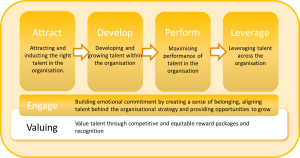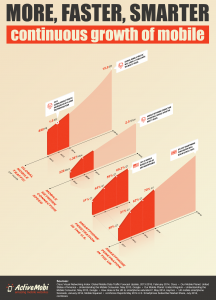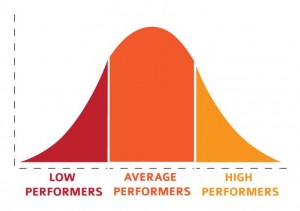Programmatic advertising is the inexpensive way to target an audience and get actionable, real-time performance insights.
This year programmatic digital display ad spending will hit $ 115.23 billion, and more than 90% of all digital display ad dollars will transact programmatically, according to eMarketer.
Why?
Because it can deliver everything traditional media ad buying can’t and more.
Traditional media ads can’t measure the true ROI of media campaigns in real-time. They don’t let you pinpoint what makes an ad and a campaign successful. Was it the creative? The copy? Where it ran? When it ran? Who saw it? Without this there’s no way to optimize the ad and try out different iterations.
Traditional media ad buying is a time- and labor-intensive process. It requires RFPs, tenders, quotes and negotiations. It requires creating and distributing physical versions of materials. All of this drives the price up.
Programmatic advertising gives you all those good, actionable insights into campaign performance. It does this while letting you target your ads to exactly the audience you’re looking for. And it does this in a more efficient, automated marketplace with far lower costs.
So here’s what you need to know about programmatic advertising.
Table of contents
- What is programmatic advertising?
- How does programmatic advertising work?
- Ad network vs. ad exchange
- Types of programmatic advertising
- How big is the programmatic advertising market?
- What are the advantages of programmatic advertising?
- How much does it cost?
- What is a retail media network?
- What are the problems with programmatic advertising?
- Five keys to programmatic advertising success
What is programmatic advertising?
Simply put, it’s the automated buying and selling of digital advertising space.
It uses algorithms and AI to run real-time auctions where ads are bought and placed at the same time as a visitor loads a website. Any and all digital formats and channels are available through these automated marketplaces. Programmatic advertising is now being used to sell ad space for CTV, digital radio and digital out of home (DOOH).
How does programmatic advertising work?
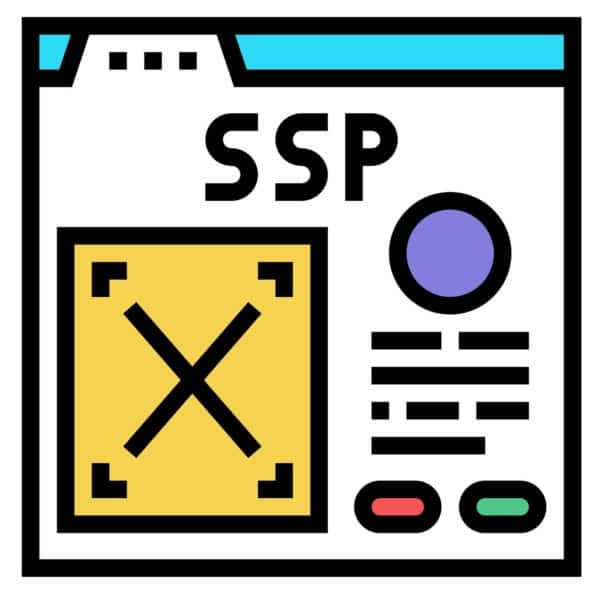
- When a person clicks on a website, the site’s owner uses a Supply-Side Platform (SSP) to notify one or multiple Ad-Exchanges to put the ad space up for auction.
- Advertisers use a Demand-Side Platform (DSP) — either via an agency or directly — to offer bids. The DSP is connected to a data management platform (DMP) which ensures the placement targets the right audience. It does this by taking a variety of factors into account, including location, demographics, user behavior and online activity. There is also contextual targeting, which uses website content — including text, keywords, images and categories — to trigger an ad purchase.
- The winning bidder’s ad is served on the site.
All this takes place in hundredths of a second.
Programmatic ad buying is also used for CTV, digital radio and out-of-home (OOH) advertising.
Programmatic is a bit different for OOH, which doesn’t have online’s one-to-one targeting capability. Instead, an OOH campaign can arrange it so ad space is programmatically purchased whenever certain conditions are met. For example, a soup company will set a buy order for when the temperature drops below a certain level. Or an allergy medicine can have a buy order set for when pollen levels rose in certain geographic areas.
Ad network vs. ad exchange
- An ad network is a platform connected to a certain number of websites, offering inventory for advertisers on those sites.
- An ad exchange is a trading floor where advertisers go to buy ad space from multiple ad networks.
Types of programmatic advertising
Because of the speed of the entire process it is referred to as Real-Time Bidding (RTB). Although the overwhelming majority of automated ad buying is RTB, there are other methods.
- Programmatic direct is buying a guaranteed number of ad impressions on specific websites or from selected publishers. While this assures ad space on specific publisher sites, it isn’t as good when it comes to audience targeting. Programmatic direct is usually used for premium, large format ads like full-page takeovers. It is more often a fixed-price agreement rather than an auction.
- Private marketplaces are invitation-only markets where a set number of publishers invite specific advertisers to bid on their ad inventory. This allows the advertiser to bypass ad exchanges and have their buying platform plugged directly into the publisher’s inventory.
- Preferred deal is a one-on-one programmatic auction where publishers sell premium inventory at a set CPM price to a selected number of advertisers. These advertisers bid in real-time at or above the fixed CPM price.
How big is the programmatic advertising market?
Huge.
In 2021, US marketers alone spent $ 167 billion on all types of programmatic advertising, according to Statista. The world-wide spending on programmatic advertising is projected to hit $ 314 billion by 2026, per Technavio.
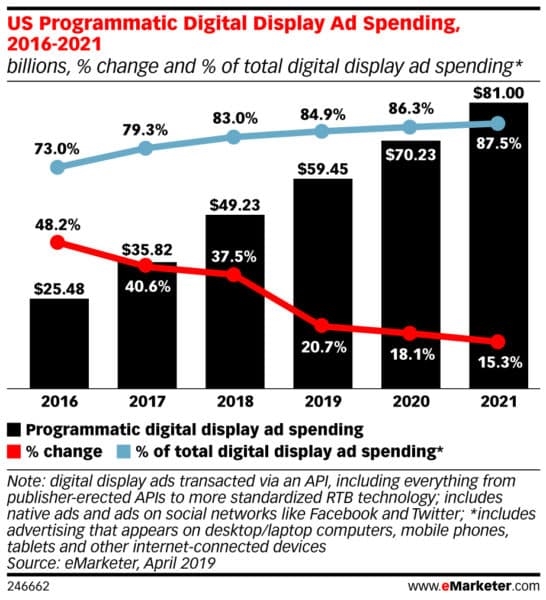
In the U.S., programmatic digital display ad spending is projected to account for $ 115.23 billion in ad dollars in 2022, making up 90.2% of the digital display ad market, according to eMarketer.
- By 2026, 86% of overall digital advertising revenue will come from programmatic ads (Statista).
- Next year programmatic digital display will make up 91% of all US digital display ad spend (InsiderIntelligence).
- In 2023, programmatic video advertising spend will be more than double what it was in 2020 (InsiderIntelligence).
- US connected TV programmatic display ad spend will reach a record $ 8.88 billion in 2022 (Statista).
- US programmatic digital radio ad spend will surpass $ 1 billion for the first time ever in 2022 (Statista).
- US programmatic digital out of home ad spending is set to reach $ 533.8 million in this year. (InsiderIntelligence).
What are the advantages of programmatic advertising?
Traditional media buying is a labor and time intensive process requiring everything from requests-for-proposals to negotiations to manual insertions of the orders. Programmatic is automated and efficient.
Other benefits include:
- Scale. Advertisers can reach large audiences by purchasing ad space from any ad inventory available programmatically. Publishers have access to a huge pool of buyers.
- Insights. Provides real-time data and advanced reporting about ad placements and performance, making it easy to quickly optimize campaigns.
- Targeting. An advertiser’s budget can be put to better use and spent more efficiently by targeting the people most likely to buy their product.?
- Efficiency. The process is faster and less expensive than older methods. Access to a large pool of publishers means advertisers can get a better ROI.
- Revenue. Optimizes the bidding process, so publishers and advertisers get the best price possible.
- Ease of use. Automation makes buying ads and selling ad inventory a simple process with low overhead.
How much does it cost?
Programmatic advertising costs can vary because they are priced by cost per 1,000 ad impressions. This is called CPM — cost per mille (mille is French for thousand).
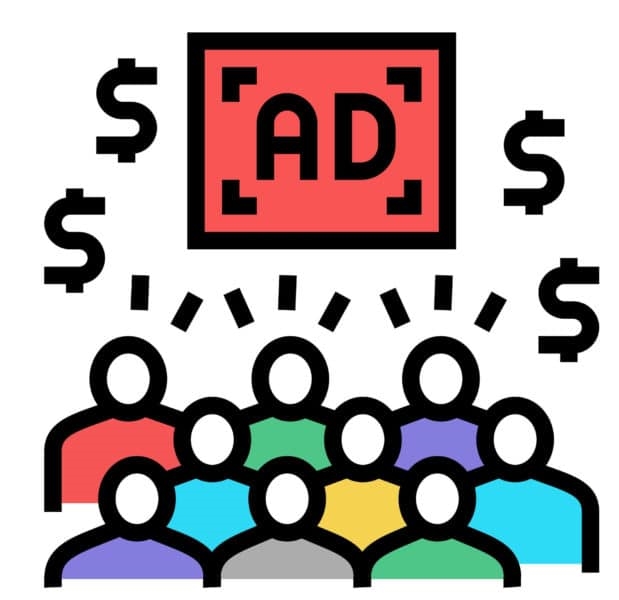
The more specific the targeting, the higher the cost. Other things influencing the price include:
- Type of industry.
- Targeted device.
- Ad format.
- Ad placement on the page.
On average, programmatic CPMs tend to be less expensive than social media advertising and can offer significantly better value than offline advertising.
What is a retail media network?
Retail media networks are networks owned by a specific retailer where brands can buy programmatic advertising for inventory on their website, apps and other digital properties, including in-store. It also lets them run ads on the open web. Retailers can partner with media companies and give brands expanded reach and improved targeting with the use of in-depth shopper data.
The nine largest U.S. brick-and-mortar retail media networks are (in order) Walmart, Target, Kroger, Best Buy, Home Depot, Macy’s, Ulta, CVS and Walgreens.
One-quarter of retailers are generating more than $ 100 million in revenue from their media networks, according to Forrester. That’s made these networks a game changer for many retailers — and a potential lifeline in a worsening economy. Retail profit margins tend to be slim — in the 3% to 4% range. The margin on ad sales is usually 70% to 90%, according to BCG. And sales are very good.
According to MediaRadar:
- In the eight months from May 1, 2021 to the end of January in 2022, more than 23,500 companies bought ads on retail media networks.
- 14% bought ads every month; the retention rate from December to January was 59%.
- 24% of the companies advertising in January 2022 were first-time buyers.
Furthermore, the retail media market will grow by 25% per year to $ 100 billion over the next five years and will account for over 25% of total digital media spending by 2026, according to BCG. Also important: This is new revenue for retailers. Per BCG: 60% to 70% of the projected $ 100 billion in 2026 retail media revenue will be net new spending over and above historical trade dollars.
What are the problems with programmatic advertising?
While programmatic may seem to be a miracle cure for all marketing needs, it isn’t. There are very real problems with it, including data accuracy, collusion by ad sellers and buyers, and click fraud.
Third-party cookie depreciation
Programmatic ad targeting is only as good as the data it’s based on. For now, much of that data is collected via third-party cookies. How much longer that will be the case is anyone’s guess. There are strict restrictions on them in the EU, and Apple users must take the step of approving their use. Their death knell will come when and if Google ever decides to restrict their use. While they’ve talked about doing this, any action keeps getting kicked down the road.
There are a lot of workarounds if it does come to pass, but they are expected to make data and ads that depend on data more expensive.
Collusion
Ten states have filed a lawsuit against Google and Facebook parent company Meta charging them with colluding to force out competition in the online advertising sector. Google is also under investigation by the Department of Justice over another set of antitrust issues. That investigation focuses on allegations the company is exploiting its position as broker and auctioneer of digital advertising.
“The conflicts of interest are so glaring that one Google employee described Google’s ad business as being like ‘if Goldman or Citibank owned the NYSE,’” said Sen. Mike Lee (R-UT). Lee is co-sponsor of a bill to force the company to divest its adtech business.
Fraud
Programmatic ad fraud is a big, well-known problem that no one seems interested in fixing. Just look at these numbers:
- $ 23 billion: Expected U.S. ad spend lost to fraud this year. (Juniper Research)
- $ 100 million: Amount per day U.S. companies are expected to be losing to advertising fraud in 2024, an increase of 125% since 2018. (TrafficGuard)
- 38%: Amount of web traffic that is automated/bots. (Imperva)
- 24%: Amount of web traffic that bots used for fraud and theft. (Imperva)
- 14%: Average clicks from fake sources in each paid search campaign. (ClickCease)
- $ 1: Amount lost to fraud out of every $ 3 spent by advertisers. (Interceptd)
- $ 5: Amount a botnet owner is charging per 1000 clicks. (ClickCease)
- 73%: Number of U.S. businesses saying ad fraud is a problem for them. (Netacea)
You would think that, given these costs, someone would try to clean up the situation. In an interview with MarTech, cybersecurity and anti-ad fraud consultant Augustine Fou, explained why this is unlikely to happen.
“The advertisers who are paying the money, they want to buy hundreds of billions of ad impressions,” Fou said. “You can’t buy that much quantity without the fraud. Most humans visit a small quantity of sites repeatedly. That’s where you get the large quantities of human audiences. When you get into the long tail, there’s just not enough humans to generate that many ad impressions. The only way to do that is by using bot activity to repeatedly load the web pages and cause ads to load. As a result, basically every middleman, every ad exchange, every publisher has incentives to use more fraud. So that’s why I said ad fraud has not been solved because nobody wants to solve it. Even the advertisers, even the middle men. Everyone wants it to continue because they’re making money.”
Five keys to programmatic advertising success
1: Targeting and segmentation
Programmatic advertising is designed to get your message in front of the right people at the right time. However, it needs you to determine who and when that is. Strong audience targeting is the most important piece of a successful programmatic ad campaign.
Targeting lets you reach high-value prospects and exclude non-performing ones, thereby getting the most out of your ad buy. You do this by segmenting users into specific audiences based on predefined criteria.
This means you have to do a lot of deep research into your target audience before doing any planning for your campaign.
2: Personalization
Programmatic lets you be very specific about who you reach, so your ads need to be designed specifically for those people. They must be highly relevant and customized with the right creative and messaging specific to your target audience. This will get you the higher conversion rates and better ROI which define success.
Data-driven or data-responsive creatives can help you do this. They use machine learning to find out which variations of an ad will have the most appeal for a specific user.
Don’t forget about contextual targeting! You should use a variety of ad types for your contextual targeting campaign. Video ads, native ads and behavioral ads have been found to be top performers..
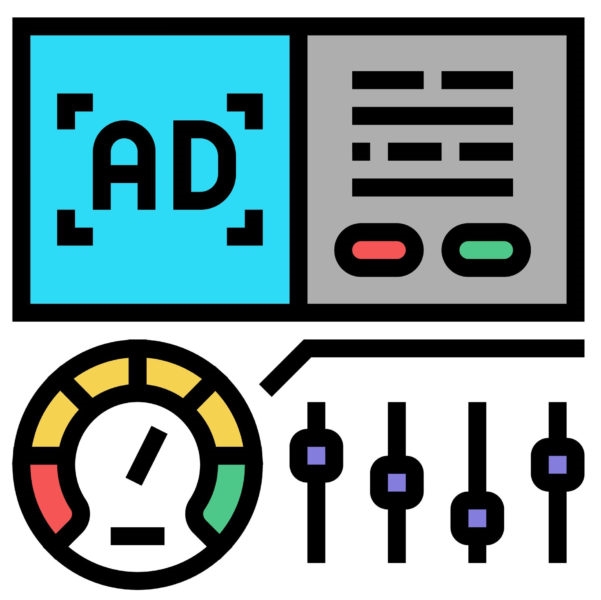
3: Essential metrics
- Cost per Click (CPC): Look for ad suppliers whose price is in your ideal CPC range. Make a preferred list of those sites and an exclusion list of those vendors outside your CPC range.
- Click-through Rate (CTR): Put the sites delivering good CTR on a preferred list and increase the amount you are willing to bid for their inventory. Either block lower performing sites or determine if there’s a low enough price to justify using them.
- Cost per Completed View (CPCV): Again, create a list of sites that are meeting your desired CPCV and block those outside that range.
4: Making it multi-channel
Your ads are going to run on many different channels and many different devices. Use attribution models to measure the performance on each of those.
Setting up an attribution model — last touch, multi-touch or linear — for your campaign means this will be measured on all platforms, even outside programmatic. This will help you assess performance on each separate platform and for the entire campaign.
Correctly attributing conversion credit lets you see which campaigns are doing well and which aren’t. That, in turn, lets you know which campaigns you should run more and which ones need to be reworked or ended.
Also, be sure all creatives are optimized for all channels and devices. What looks great on YouTube on a tablet may be a mess to someone using TikTok on their phone.
5: Frequency caps
Repetition gets old fast. Seeing the same ads over and over can cause even the best creative to become annoying. The solution is analyzing performance and implementing frequency caps.
These let you control the number of impressions for specific users on a monthly, weekly or hourly basis. By analyzing this data you can identify different users cross-channel and then prevent them from being hit with the same ad everywhere they look.
This also helps you budget more efficiently by redirecting impressions from one user to another. When one user hits the impression limit on a particular ad, you can redirect to a different user.
This gets your ad in front of more of your target audience without increasing ad spend.
The post What every marketer needs to know about programmatic advertising appeared first on MarTech.
(20)
Report Post


